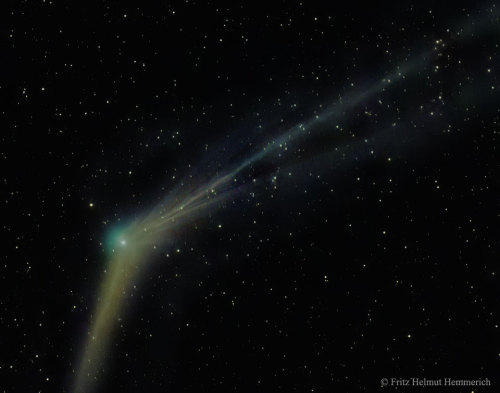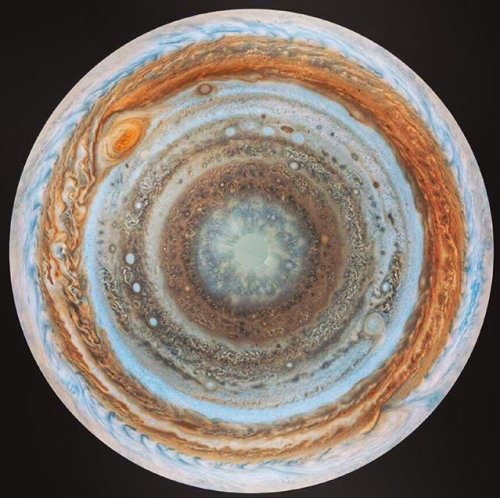Solar Filaments A.k.a. Prominences – When Observed At The Solar Limb (above), Are Long Clouds Of

Solar filaments a.k.a. prominences – when observed at the solar limb (above), are long clouds of partially ionized plasma suspended above the Sun’s surface by strongly sheared magnetic structures, called filament channels, that can support the dense plasma against solar gravity. Filaments may form at various locations on the Sun, however, they are always found within preexisting filament channels above polarity inversion lines which separate areas of opposite magnetic polarity regions.
Credit: NASA/SDO/LMSAL
More Posts from Littlecadet-biguniverse and Others

Comet Catalina Emerges : Comet Catalina is ready for its close-up. The giant snowball from the outer Solar System, known formally as C/2013 US10 tails, making it an impressive object for binoculars and long-exposure cameras. The featured image was taken last week from the Canary Islands, off the northwest coast of Africa. Sky enthusiasts around the world will surely be tracking the comet over the next few months to see how it evolves. via NASA
js

A HD Sweep Of Pluto!
Click on the image above to see a HD sweep of the surface of Pluto from NASA’s New Horizons Spacecraft! This is a short post made to accompany my other Pluto post here!
Credits: NASA/New Horizons/Jhu

ESO 378-1
Do telescopes actually take colorful photographs or are the pretty colorful photographs of galaxies that we know colored afterwards? If a human was floating through space, would space look colorful to them?
So some pictures are taken in different wavelengths to see different characteristics. (infrared wavelengths to see through thick gas and dust, xray wavelengths to see highly energized regions)
But, in the visible wavelengths you are seeing the colors. They’re just enhanced brighter than they might be.
For example, I took this picture of “the California Nebula” using a camera (Canon 60Da) attached to a telescope. This shows one exposure, and the background is red due to effects of the camera (which you subtract):

You take multiple exposures, combine them, subtract the background effects & adjust the color a little and get this…


The giant star Zeta Ophiuchi

Wide-field view of the sky around the exotic binary star system AR Scorpii
This wide-field image from the Digitized Sky Survey 2 shows the rich starfields surrounding the exotic binary star system AR Scorpii.
Credit: Digitized Sky Survey 2. Acknowledgement: Davide De Martin


NGC 2736: The Pencil Nebula
js

Jupiter’s south pole, taken by Cassini
-
 neoximilien reblogged this · 1 month ago
neoximilien reblogged this · 1 month ago -
 onekindredspirit liked this · 4 months ago
onekindredspirit liked this · 4 months ago -
 ashleighxcx reblogged this · 1 year ago
ashleighxcx reblogged this · 1 year ago -
 ashleighxcx liked this · 1 year ago
ashleighxcx liked this · 1 year ago -
 last-baron liked this · 1 year ago
last-baron liked this · 1 year ago -
 ultra-zaitsev23 liked this · 1 year ago
ultra-zaitsev23 liked this · 1 year ago -
 scarlet47ohara reblogged this · 1 year ago
scarlet47ohara reblogged this · 1 year ago -
 castcastle liked this · 1 year ago
castcastle liked this · 1 year ago -
 castcastle reblogged this · 1 year ago
castcastle reblogged this · 1 year ago -
 bazookadeathmatch reblogged this · 1 year ago
bazookadeathmatch reblogged this · 1 year ago -
 couture-ephemeralia liked this · 1 year ago
couture-ephemeralia liked this · 1 year ago -
 jeremy-ad liked this · 1 year ago
jeremy-ad liked this · 1 year ago -
 awesomerealsauce liked this · 1 year ago
awesomerealsauce liked this · 1 year ago -
 thund3rlord7 reblogged this · 1 year ago
thund3rlord7 reblogged this · 1 year ago -
 thund3rlord7 liked this · 1 year ago
thund3rlord7 liked this · 1 year ago -
 harshethic liked this · 1 year ago
harshethic liked this · 1 year ago -
 cl-ea-cl liked this · 1 year ago
cl-ea-cl liked this · 1 year ago -
 16bitness liked this · 1 year ago
16bitness liked this · 1 year ago -
 splash013 liked this · 1 year ago
splash013 liked this · 1 year ago -
 vistadreams reblogged this · 1 year ago
vistadreams reblogged this · 1 year ago -
 regular-ordinary-human liked this · 1 year ago
regular-ordinary-human liked this · 1 year ago -
 sumac3000 liked this · 1 year ago
sumac3000 liked this · 1 year ago -
 sagewonders liked this · 1 year ago
sagewonders liked this · 1 year ago -
 headlesssamurai reblogged this · 1 year ago
headlesssamurai reblogged this · 1 year ago -
 beba-violetta liked this · 3 years ago
beba-violetta liked this · 3 years ago -
 joeldirtybastard reblogged this · 5 years ago
joeldirtybastard reblogged this · 5 years ago -
 quillll reblogged this · 5 years ago
quillll reblogged this · 5 years ago -
 ok321letsgo reblogged this · 5 years ago
ok321letsgo reblogged this · 5 years ago -
 saccidananda liked this · 5 years ago
saccidananda liked this · 5 years ago -
 donnie2u reblogged this · 5 years ago
donnie2u reblogged this · 5 years ago -
 batangulap liked this · 5 years ago
batangulap liked this · 5 years ago -
 quillll liked this · 5 years ago
quillll liked this · 5 years ago -
 thehouseof9 liked this · 5 years ago
thehouseof9 liked this · 5 years ago -
 virus-babalon23 reblogged this · 5 years ago
virus-babalon23 reblogged this · 5 years ago -
 synn8 liked this · 5 years ago
synn8 liked this · 5 years ago -
 gustavopereirax liked this · 5 years ago
gustavopereirax liked this · 5 years ago -
 roarman1023 liked this · 5 years ago
roarman1023 liked this · 5 years ago -
 ok321letsgo liked this · 5 years ago
ok321letsgo liked this · 5 years ago
GREETINGS FROM EARTH! Welcome to my space blog! Let's explore the stars together!!!
144 posts
